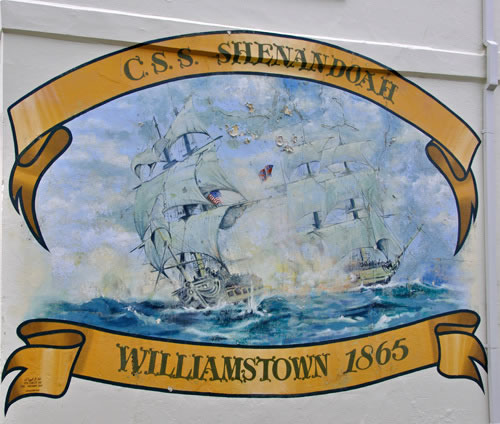CSS Shenandoah | 1864 - Melbourne |

CSS Shenandoah | 1864 - Melbourne's Civil War Connection
Like most of the world's great cities, Melbourne is full of history, but I wonder how many Melburnians know that a slightly bizarre, and very compelling chapter of the American Civil War was played out right here in Melbourne, which had the potential to plunge the Australian colonies into a war with Russia and the Union States of America.
The Confederate States warship Shenandoah started life as a British troop transport the Sea King, a sailing ship with auxiliary steam engine. Purchased by the Confederacy, she was secretly moved from England to the Canary Islands, to convert her into a fighting ship.
On 19th October 1864, Sea King's conversion was complete. She was re-commissioned CSS Shenandoah under the command of first Lieutenant James Iredell Waddell, but with a compliment of less than half the crew normally needed to sail and fight such a vessel.
Over the next six weeks, Shenandoah scoured the South Atlantic, destroying or bonding over eight Union ships, before developing a problem with her propeller shaft, off the coast of South America.
Requiring a dry-dock to effect repairs, Waddell identified Cape Town as the closest neutral port, but was reluctant to go there, for fear of Union warships patrolling the area. Instead he elected to set course for Melbourne, 9600 kilometres away.
And so it was that Waddell and his crew found themselves at the centre of attention as they dropped anchor in Hobson's Bay on Wednesday, January 25th 1865.
Shenandoah's assistant surgeon wrote that: "Never was conquering flag at peak hailed with such honours as were given us upon that bright tropical morning. Steamer, tugboat, yacht - all Melbourne in fact, with it 180,000 souls, seemed to have outdone itself in welcome to the Confederates".
The people of Melbourne flocked to Williamstown to see Shenandoah; as many as 10,000 on a single day.
With the ship slipped and repairs under way, her officers were entertained at the prestigious Melbourne Club; they toured the Ballarat gold diggings, and were guests of honour at a gala ball held at Craig's Royal Hotel.
With all this going on, US Consul William Blanchard pressured local authorities to seize the ship, amid reports that Waddell was recruiting locals as crew. If such reports were true, they would represent a significant breach of Victoria's neutrality, and had the potential to plunge the colony into a war with Russia and the Union States of America.
Throughout the Civil War, the Union States were allied with Russia against a perceived possible common enemy, Great Britain. Colonial authorities had known for some time that the Russian Pacific Fleet had orders to fire on British ships in Australian waters, and to destroy coastal batteries at Sydney, Melbourne and Hobart, if hostilities flared between Britain and the Russian/American alliance.
For three weeks, Melbourne was shrouded in a game of political cat and mouse as Blanchard pressed local authorities to intervene, amid reports of as many as forty locally recruited men having been conveyed to Shenandoah.
On two occasions, government officials sought to search the ship, but were refused permission to board. Then, on 14th February, Constable Alexander Minto of the Williamstown Water Police witnessed two men leaving Shenandoah and, believing them to be British citizens who had joined the ship, placed them under arrest.
Those arrests sent shockwaves through the Government. Governor Charles Darling demanded Waddell leave Melbourne by 19th February.
At 4 PM on Saturday, 17th February, Shenandoah upped anchor, and steamed down the Bay and through The Rip. As she headed into International waters,, forty-five new crewmen were ushered on deck and enlisted into the Confederate Navy.
Over the next six months, Shenandoah cruised north through the Pacific, destroying American ships on the way, until reaching the Baring Sea and the Siberian coast, where the Confederates set about destroying a large part of the American Arctic whaling fleet.
On 2nd August, news arrived that the Confederacy had surrendered and the war was over. Waddell had the crew disarm Shenandoah and set course for Sydney, but later changed his mind and altered course for Liverpool, England.
Four months and 37,000 kilometres later, Shenandoah entered the Mersey, where Waddell surrendered to the Commander of a British warship.
In her 13 months as a commerce raider, Shenandoah had sailed or steamed 93,340 kilometres, and destroyed or bonded over thirty-six enemy ships. She was the only Confederate warship to circumnavigate the globe, had fired the last shot of the American Civil War, and was the last Confederate military unit to surrender. Not a single crew member was lost to enemy action.
Seeking out some of Melbourne's early maritime history can form the basis of a great day out to Williamstown, but you won't find too much there to commemorate the Shenandoah visit. Almost all that remains today are a couple of large murals on a building in Ann Street, the work of artist Daryl Fox. They were originally painted in 1987, and restored in 2001.
The nearby Seaworks historic maritime precinct occupies the original Melbourne Harbour Trust Stores & Workshops, not far from where Shenandoah was slipped, and aims to showcase Williamstown's colourful maritime heritage.
Seaworks"Pirates Tavern"is one of Melbourne's best-kept secrets, and the perfect spot for a cold drink while soaking up some serious maritime history. The Tavern is open Friday's from 7 PM, and the 1st and 3rd Sunday of the month, between 1 PM and 6 PM.
Source: by Ian Gill
❊ Web Links ❊
➼ CSS Shenandoah | 1864 - Melbourne
➼ www.wma.org.au
Disclaimer: Check with the venue (web links) before making plans, travelling or buying tickets.
Accessibility: Contact the venue for accessibility information.
Update Page








